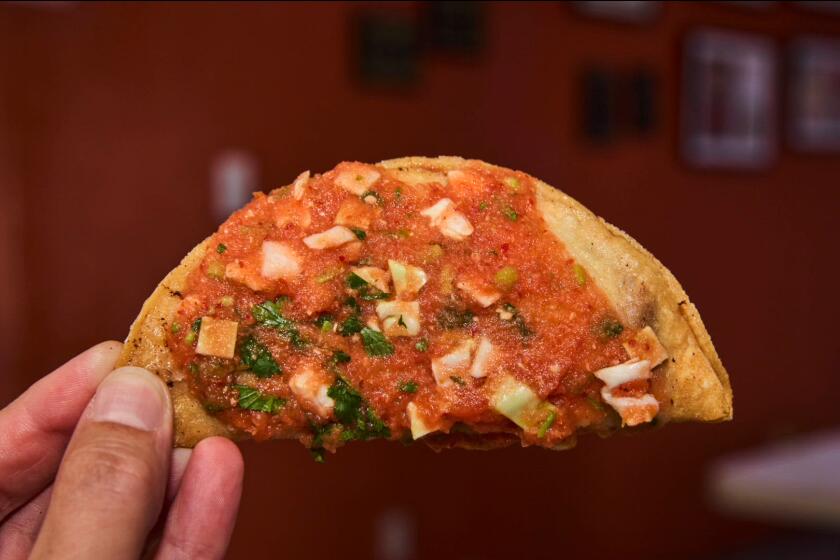Beer : The New U-Brew School of Beer-Making
Following a recipe based on one first scratched in hieroglyphics some 7,000 years ago, I measured out two pounds of grain, ground it up, added nine gallons of water and waited.
Making beer, though it’s as old as bread-baking, is these days a most precise art. To make it consistently well requires pristine equipment and, as Prof. Harold Hill might say, a cool head and a keen eye.
Many of those who decry the blandness of commercial American beer become home brewers, investing in specialized equipment and taking over some (or all) of the garage, carport or RV space.
But if you’re unprepared for that kind of investment and still wish to explore the adventure of turning grain, hops and water into a sublime brew, you can now put your money where your mouth is and brew your own at a South Bay beer-making shop.
The Hamilton Gregg Brewworks, which opened July 1, offers adventuresome brewers a chance to see how beer is made. They then take home 48 (22-ounce) bottles--the equivalent of almost four cases--at a price not much higher than that of standard beers and even lower than that of some premium beers.
Located just off the Hermosa Beach Pier a block from the famed Lighthouse jazz club, the business catches the eye of dozens of curious boardwalk strollers who poke their heads into the doorway to see what’s brewin’ in the storefront operation.
At all hours of the day, but more often in the early evening, strolling couples pop in and look around at the six gleaming stainless-steel kettles, samples of past home brews, posters and other equipment.
Most merely browse; a few are fascinated with the idea of making their own beer and ask for particulars. Frequently, they return to brew some of their own. I did.
After I added the grain to the water at precisely 155 degrees, there was a 20-minute wait to gather the rest of the materials. I asked Anthony Gregg, one of the owners, exactly what kind of beer I was making.
“I think we have some that someone brewed last week,” he said and went into the back. He poured me an ounce and a half of the same beer and asked if it was what I liked.
“I think I’d like it a bit more bitter--but maybe we’ll leave the recipe alone this first time,” I said, sounding as if I’d be back.
The rest of the beer-making process was simple. I added pitchers of syrupy grain extracts from a giant drum--some American extract (lighter in color and aroma) and some Continental extract (amber, more flavorful). I added some hops (Northern Brewer, which came in pellet form, and Cascade, which were fresh) and dextrose (corn sugar).
It all went into the kettle, which I then stirred with a huge wooden paddle--counterclockwise, so the trub (extraneous material, including the hops) would go to the center of the kettle. (If you stir clockwise, the matter would wind up on the outside of the drum and when you drained the tank, some would end up in the fermentation vessel.)
During the brewing process, brewers have 40 to 60 minutes to wait, and usually conversation begins.
“What are you brewing?” is the typical starter, and trades (“My beer for yours?”) are commonplace.
Interestingly, this business didn’t grow out of home brewing, which in the last decade has become quite a fad in California. Home brewers already know of the joys of boiling grain to extract its sugars, creating wort (pronounced wert)--the liquid into which will go the hops--and then adding yeast and fermenting the stuff until it’s beer.
The brewworks is designed for people who know little or nothing about beer but want to learn, or those who simply want to make a beer or ale with more distinctiveness than standard American brews.
The benefits are that the producer can get beer in a wide range of styles and tell friends and neighbors it was hand-brewed. This means it’s fresh, and with beer, the fresher the better. Patricia Spiritus, one of the owners of the brewworks, says that these products are best consumed within five weeks of production.
Price for this experience ranges from $80 for beer that would approximate American lagers such as Coors or Michelob to $120 for Ironman Barley Wine, a strong, near-dessert-style of brew. A comparable quantity of an American lager might sell for $60, while an equal amount of a super-premium such as Samuel Adams or an import like Heineken would be much more.
One of the attractions of this operation is the conviviality it generates. “People meet and they get to talking and one says he’d like to trade a few bottles of his beer for a few bottles of the other guy’s,” said Spiritus. “It’s a place to meet people. A few people have started dating after meeting here, but we haven’t been open long enough to host any weddings yet.”
After the ingredients are mixed and brewed in a kettle, the liquid is transferred to a small tank where the fermentation takes place for about two weeks. After that, the brewer returns to the shop to bottle, cap and label the brew.
Labeling seems to be part of the attraction. Some customers go to great extremes to be humorous; others choose a straightforward informational label, and still others spend up to a dollar per label using full color.
Some of the names include Strange Brew, Hip Hops, Butthead Brew, Fine Puma Pilsner (with a cat on the label), Hyperion Overflow Ale, Baby Brew (in honor of a birth), Howl at the Moon Lager, High Voltage Beer and Hitchin’ Post Hooch. One beer called Wombat Juice has a slogan on the side: “Better than a poke in the eye with a wet fish.”
Since all the beer made here is for home use and may not be sold (and thus doesn’t come under federal alcoholic beverage regulations), it may be labeled any way the owner wants. One ploy is to label the beer with a faux warning label, similar to the government warning that exists on all commercial alcoholic beverages.
One says, “Warning: after consuming two of these beers, do not operate heavy machinery, do not visit your gun locker, do not sell insurance, do not become amorous with your wife, less you are accused of assault with a dead weapon.” Another label reads: “Warning: this beer is self-loading. No camouflage is necessary. One of these and you’re invisible.”
Gregg and Spiritus and a third partner, John Hamilton Scudder, opened Hamilton Gregg Brewworks after months of wrangling with various local and state authorities to gain permits to open the doors. “We had to break in all the departments, the Health Department, the zoning people. . .” said Spiritus.
Gregg said health officials were concerned about cleanliness at the brewworks, but he and his partners convinced authorities “that, like the kosher hot dogs, we have to report to a higher standard, which in this case is the beer itself. Beer equipment needs to be very clean, or it won’t make very good beer.”
The equipment here is state-of-the-art in small-production brewing. The six stainless-steel brew kettles were specially designed for this kind of operation, as were many of the other pieces of equipment, including dedicated transfer lines and a modern pneumatic bottle filler.
Making beer here is easier than following a recipe in your kitchen because the measuring cups and pitchers are laid out for you and the ingredients are all easy to measure, including grain extracts from giant drums to make the brewing process easier. And the equipment is semi-automated, so there’s no messy splashing of the wort, no chance to get your clothes stained. Moreover, Gregg is standing by to offer advice.
All of the two dozen recipes Hamilton Gregg offers (at varying prices and times of production) are compared with commercial beers. The menu says that its “Czech-Mate Pilsner” is similar to Pilsner Urquell; its “Peninsula Wheat beer” is like August Schell Weiss, and that “Helmsman Bitter Ale” is like Old Peculiar.
Starting this week and continuing through the end of the year, the brewworks is offering what more unusual beers things like cranberry beer, pumpkin spice beer, orange, clover. The shop also offers three-bottle gift boxes so brewers may give their beers as presents.
Brewing beer in a do-it-yourself brewworks has become big business in Canada, where such operations are called U-Brews. There are some 275 in Canada, most in Ontario, where taxes on commercial beer are so high that a normal six-pack routinely sells for more than $5 and where imported and specialty beers run much more. The brewworks is a way around the tax man. (Recently, however, Canadian authorities have started looking at the U-Brew operations as a tax dodge, and some authorities have already moved to tax these products too.) That’s not an issue in the United States, where taxes on beer are lower.
Anticipating that brewworks will become just as popular below the border, a Canadian on-premise brewing organization is setting up shop in Los Angeles. “I expect at least half a dozen U-Brews in California within the next four to six months,” says Robert Boyd, executive secretary of the Quebec Brew-on-Premises Support Assn. The group, which is attempting to legalize brew-on-premise establishments in Quebec (where they are now not permitted), plans to form the L.A.-based Brew on Premises Assn. of California.
Beer fanatics say these kinds of brew-your-own operations have a drawback: They have no facilities to make an all-grain brew, which some purists consider better than those made with extracts.
However, Tom Dalldorf, publisher of the Celebrator, a Hayward-based beer news magazine, said it’s not necessary to have that kind of specialized equipment to make fine beer.
“The use of extracts doesn’t inhibit the ability to make a fine quality beer,” he says, pointing out that Pacific Coast Brewing Co. in Oakland, makers of Gray Whale Ale and Killer Whale Stout, “produces some of the finest examples of extract beers. Most people, even experts, don’t realize these are extract beers.”
Dalldorf said Hamilton Gregg’s concept could catch on in the United States in a big way. One reason, he said, is that home brewing is so messy.
“People in densely populated urban areas don’t have the space, and in some areas they wouldn’t be allowed to brew in their apartments,” he said. “If you desire to brew a quality beer but don’t have the equipment or the space to do it at home, then the brew-on-premise becomes like the laundromat or the wash-your-dog shop.
“Here you can let the owner worry about things such as fermentation locks, the mess of the bottling process and spills and cleanup.”
More to Read
Eat your way across L.A.
Get our weekly Tasting Notes newsletter for reviews, news and more.
You may occasionally receive promotional content from the Los Angeles Times.










